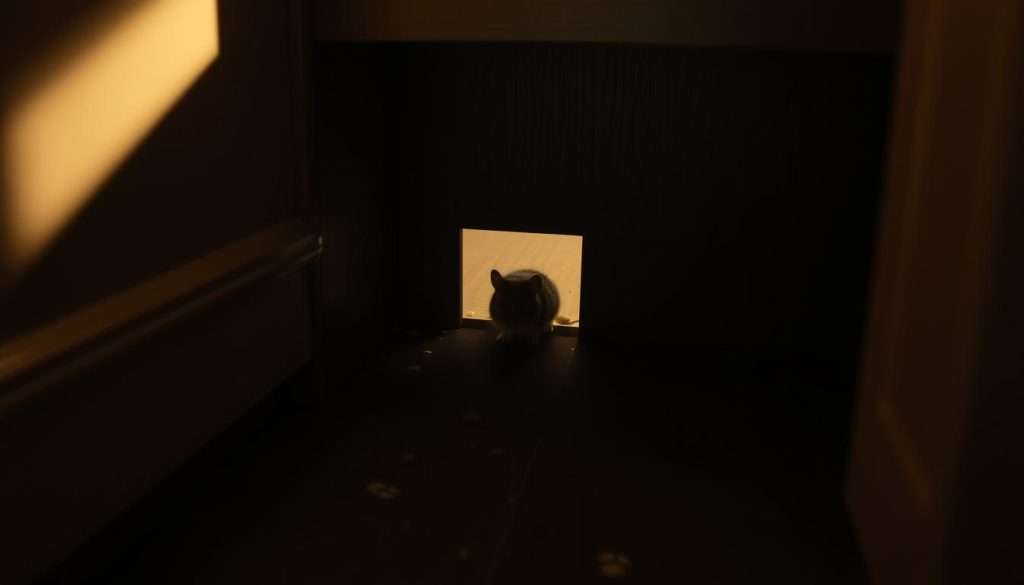Welcome to our guide on where mice hide in a house. Mice can sneak into our homes through tiny cracks. They like dark, hidden spots near heat, like water heaters. Their nests are about 4 to 6 inches wide and made from things like insulation and cardboard.
We’ll show you where mice hide and how to spot them. You’ll learn about their habits and how to keep them away. For more tips on finding mouse nests, check out this useful resource.
Key Takeaways
- Mice prefer dark, secluded areas for nesting near heat sources.
- Their nests are often constructed from household materials, highlighting a need for vigilance.
- Mice don’t travel far from their nests, making the areas nearby crucial for inspections.
- Observation of droppings and nest signs can help identify infestations early.
- Sealing cracks and entry points is essential to keep these unwanted guests out.
Introduction to Mice and Their Behavior
Knowing about mice is key for homeowners to stop infestations and keep their homes safe. Mice are a type of rodent that lives near humans. They like homes because they find food and shelter easily.
Understanding Mice as Commensal Rodents
Mice live in cities and suburbs because they’re close to people. They’re small and can climb well. This makes homes a good place for them to live, with safety and food.
Reasons for Mice Infesting Homes
There are many reasons why mice infest homes:
- Escape from Weather: Mice hide from bad weather and storms.
- Protection from Predators: They find safe spots away from predators.
- Food Sources: Homes have lots of food, like crumbs and spills, attracting mice.
This leads to more mice because female mice can have up to 35 babies a year. This makes the problem worse.
Common Mouse Hiding Spots
Mice are smart and look for places to hide and find food. Knowing where they hide helps us find them. Here are some places mice like to hide.
Kitchens: A Preferred Location
Kitchens are a top spot for mice. They like to hide under big appliances like fridges and stoves. They also hide in cabinets, where they find crumbs and food.
This is because kitchens are close to food. To keep mice away, keep your kitchen clean and remove food that attracts them.
Basements and Garages: Ideal Habitat
Basements and garages are great for mice. They are dark and cluttered, perfect for hiding. Appliances like furnaces keep them warm.
To stop mice, organize your storage and check these areas often. This helps keep them away.
Attics: The Overlooked Abode
Attics are often missed when looking for mice. They have insulation and cardboard boxes, attracting mice. Attics are quiet, letting mice hide without being found.
Checking attics often can help find mouse nests early. This stops bigger problems later.

Where Do Mice Hide in a House
Knowing where mice hide in a house is key to controlling pests. Finding where mice make their nests can help stop infestations. Mouse nests in homes are often hidden, so being alert is important for homeowners.
Specific Areas to Search for Mouse Nests
To find mouse nests in your home, look in these places:
- Indoor Hiding Spots: Mice like to hide behind kitchen appliances, in wall voids, or in attics. They use things like shredded paper, cardboard, and insulation.
- Closets: Keep closets clean and organized to stop mice from nesting in corners or among forgotten things.
- Basements: Basements can be a good shelter, especially if they are cluttered. Look for signs of nesting there too.
Signs of Infestation in Hidden Areas
Spotting signs of mice can save you a lot of trouble:
- Mouse droppings, which look like grains of rice, mean mice are around.
- Gnaw marks on furniture, baseboards, or walls show mice are active.
- Listening for scratching sounds at night can tell you they’re up and about.
- Looking for chewed wires or fabric can also show mice are there.
Understanding Mouse Entry Points
To keep mice out of your home, you need to know how they get in. Learning about mouse entry points helps you stop them before they start.
Common Entry Pathways into Homes
Mice are very good at finding small openings. They often come in through:
- Poorly fitted doors
- Cracks in walls
- Big gaps under garage doors
- Spaces around pipes, gas lines, or electrical wiring
They can fit through holes as small as a dime or nickel. It’s important to check these spots often. Sealing entry cracks is a key part of keeping your home mouse-free.
Identifying and Sealing Potential Entry Cracks
Check your home’s outside carefully. Look for:
- Gaps in the foundation
- Gnawed areas around doors and windows
- Holes near kitchen cabinets, baseboards, air vents, and appliances
Mice can cause safety risks by chewing on wires and pipes. To block their way, use steel wool for small holes and caulk for big gaps. These materials work well together to seal any openings. For more help with pests, you can contact pest control professionals if you think you have a problem. Catching and sealing entry points early can help avoid a mouse problem.

| Material | Best Usage | Advantages |
|---|---|---|
| Steel Wool | Small Holes | Prevents easy entry, durable against chewing |
| Caulk | Larger Gaps | Effective sealing, flexible and weather-resistant |
Signs of Mice Infestation
Finding out if mice are in your home means looking for certain signs. Each sign tells you about the type of mouse and how bad the problem is. Knowing how to spot mouse droppings and hearing mouse sounds helps you react fast.
Recognizing Mouse Droppings and Other Indicators
Mouse droppings are a key sign of mice. They are small, less than ¼ inch, and pointed at both ends. You usually find them near where you store food. Fresh droppings are dark brown or black. Older ones are harder and crumble easily.
The amount of droppings shows how bad the problem is:
- Many droppings: Means there are a lot of mice.
- Gnawed holes: Small holes, about the size of a dime, show mice are around.
- Rub marks: Dark smudges on walls where mice often go.
- Gnaw marks: Clear grooves on wood and plastic show mice are active.
Sounds and Sightings: How to Detect Mice
Mice make scratching and scurrying sounds, especially at night. They are most active then. Also, watch your pets. They might bark or paw at areas where mice are.
Being alert to these signs helps you deal with mice early. If you see any signs, like a strong musky smell, it’s time to take action.
Conclusion
Knowing where mice hide in your house is key to keeping them away. Mice can fit through tiny openings, like 1/4 inch gaps. So, it’s important to check your home often for these spots and seal them up fast.
Using mouse control methods, like steel wool and storing food right, can help a lot. This can lower the chance of mice taking over your home.
In places like Maryland, mice might seek shelter inside when it’s cold. Without steps to stop them, a few mice can turn into a big problem. Keeping up with home checks and upkeep helps keep your space mouse-free.
If you think you have a big mouse issue, getting help from pest control pros is a good idea. They have the skills to get rid of mice for good. Being ready with these steps helps protect your home and keeps you calm.
